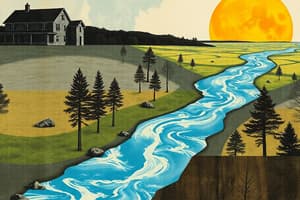Podcast
Questions and Answers
What is the correct definition of infiltration?
What is the correct definition of infiltration?
- The transfer of water from plants to the atmosphere.
- The conversion of water into vapour by solar energy.
- The process where water moves horizontally through the soil.
- The soaking of water into permeable rock. (correct)
Which of the following is not a transfer/process/flow in the hydrological cycle?
Which of the following is not a transfer/process/flow in the hydrological cycle?
- Transpiration
- Condensation of soil (correct)
- Evaporation
- Precipitation
What term describes the water that moves over the surface of the ground?
What term describes the water that moves over the surface of the ground?
- Groundwater flow
- Percolation
- Surface run-off (correct)
- Infiltration
What is the term for water vapor turning back into tiny water droplets?
What is the term for water vapor turning back into tiny water droplets?
Which of the following accurately describes the hydrological cycle?
Which of the following accurately describes the hydrological cycle?
Flashcards are hidden until you start studying
Study Notes
The Hydrological Cycle
- The hydrological cycle is a continuous process that involves the movement of water on, above and below the surface of the Earth.
- The cycle is also known as the water cycle.
Processes in the Hydrological Cycle
- Evaporation: The process of liquid water turning into water vapor, driven by heat from the sun.
- Transpiration: The release of water vapor from plants.
- Condensation: Water vapor in the atmosphere cools and changes back into tiny water droplets, forming clouds.
- Precipitation: When the water droplets in clouds become heavy enough, they fall back to Earth as rain, snow, sleet, or hail.
- Interception: Water that is caught by vegetation before it reaches the ground.
- Infiltration: The process of water soaking into the ground.
- Percolation: Water moving vertically downwards through the soil and rocks.
- Surface Run-off: Water flowing over the land surface.
- Groundwater Flow: Water flowing sideways through the soil.
Drainage Basins
- Drainage basin: The area of land where all the water drains into a particular river or lake.
- Watershed: The boundary of a drainage basin, marked by higher ground.
- Confluence: The point where two rivers meet.
- Mouth: The place where a river enters a lake, sea or ocean.
Studying That Suits You
Use AI to generate personalized quizzes and flashcards to suit your learning preferences.




